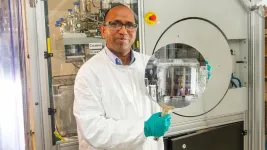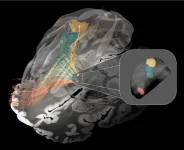(Press-News.org) While the microchips inside electronic devices like cell phones and computers are incredibly small, transistors — the tiny electrical switches inside of microchips — are approaching the atomic level. Today’s microchips pack over 100 million transistors in an area the size of a pin head.
Despite their almost unimaginable size, the total number of such microelectronic devices consume an enormous amount of energy, which is growing exponentially. Predictions indicate that 20% of the world’s energy could be consumed by microelectronics by 2030.
“It is only recently that microelectronics started using a large fraction of the Earth’s electricity. This is an urgent problem. The Department of Energy is committed to finding energy-efficient solutions that will flatten the demand curve for electricity use by microelectronics.” — Jeffrey Elam, director, Argonne’s Atomic Layer Deposition research program
Averting this crisis hinges on developing new transistors, materials and manufacturing processes to create ultra-low-energy microchips. Recently, the U.S. Department of Energy (DOE) awarded DOE’s Argonne National Laboratory $4 million to fund research that will use atomic layer deposition (ALD) to advance new materials and devices for creating microchips that use up to 50 times less energy than current chips.
Set to launch in early 2024, the project — which will last two and a half years — is funded by the Energy Efficient Scaling for Two Decades (EES2) program of the DOE’s Advanced Materials and Manufacturing Technologies Office. Argonne will partner with Stanford University, Northwestern University and Boise State University on the project. Argonne Distinguished Fellow Jeffrey Elam, who founded and directs Argonne’s groundbreaking ALD research program, will lead the research team.
“It is only recently that microelectronics started using a large fraction of the Earth’s electricity,” said Elam. “This is an urgent problem. DOE is committed to finding energy-efficient solutions that will flatten the demand curve for electricity use by microelectronics.”
Advanced technology, including the artificial intelligence (AI) explosion, is speeding up the pace at which energy is used in computing. AI applications analyze massive amounts of data and consume large amounts of electricity. As AI becomes widespread, enormous data centers that power those applications will face significant energy increases. The proliferation of “smart” devices and their data requirements also increase electricity use.
“Computers today spend over 90% of their energy shuttling data back-and-forth between the memory and logic functions, which exist on separate chips,” Elam said. “This limitation is known as the ‘von Neumann bottleneck.’ Energy used to move the data is wasted as heat. As computing demand grows, we must develop low-power transistors and microchips to overcome this bottleneck and prevent an energy crisis.”
The project grew from Argonne’s Laboratory Directed Research and Development Program activities and a project funded by the DOE’s Office of Science. Threadwork is a research program that applies co-design to develop neuromorphic devices and terahertz interconnects that will enable high-performance detectors for high energy physics and nuclear physics.
Using atomic layer deposition to redesign the microchip
Argonne is a pioneer in ALD, a thin-film deposition technique used extensively in microelectronics manufacturing. ALD produces extremely thin layers — only one-atom thick — to make microelectronics with great precision. These films are considered 2D since they have length and width, but essentially no thickness. A wide variety of thin films can be prepared by ALD on complex, 3D substrates.
“Atomic layer deposition is an ideal technology for fabricating ultra-low power electronics,” said Elam, an ALD researcher for more than 20 years. This makes ALD attractive for uses including lithium-ion batteries, solar cells, catalysts and detectors.
In this project, Argonne scientists will use ALD to redesign the microchip and eliminate the back-and-forth shuffling of data. Scientists want to close the gap between the microprocessor, or “brain,” and the memory chips. 3D integrated circuits can stack the memory and logic layers on top of each other, pancake-style. This could potentially reduce energy usage by 90%.
Currently, silicon is the semiconducting material used to make memory chips and microprocessors, but the 3D integration necessary to stack the layers is extremely difficult to achieve with silicon. Semiconductors control electric currents.
To overcome this limitation, researchers are developing an alternative, 2D semiconducting material, molybdenum disulfide (MoS2), to replace silicon. Building on previous research, Argonne scientists are using ALD to create atomically precise MoS2 films. “We can create extremely thin, 2D MoS2 sheets. These sheets will replace the bulky, 3D silicon thin films used in today’s transistors. This leaves more room on the microchip to effectively stack the memory and logic together, dramatically reducing energy,” Elam said.
New electronic devices increase energy efficiency
Argonne, in collaboration with Boise State University, developed ALD methods for creating 2D MoS2 films. The team will demonstrate the use of MoS2 to create 2D semiconductor field effect transistors (2D-FETs) that can be stacked in 3D. FETs are conventional transistors but are based on 2D rather than 3D materials. This method allows the integration of memory and logic functions not possible with silicon.
Simultaneously, Argonne scientists are demonstrating the use of ALD MoS2 in memtransistors, electronic components used to build neuromorphic circuits. Neuromorphic circuits mimic connections between neurons in the brain to create microchips that use significantly less energy. This technology is relatively new. But neuromorphic circuits have the potential to use one million times less energy compared to conventional silicon devices.
Both 2D-FETs and memtransitors have been successfully demonstrated at the lab scale by growing MoS2 at high temperatures. Argonne scientists want to take the technology to the next level. Commercial manufacturing will require MoS2 to be deposited on large, pizza-sized wafers at low temperatures. In this DOE project, the research team will develop these capabilities to ensure that the MoS2 ALD is compatible with current semiconductor manufacturing processes. This is crucial to accelerating the integration of this technology into future semiconductors.
Scientists at the partner institutions will use their unique expertise to advance specific areas of the project. Professor Eric Pop at Stanford University will develop 2D-FET devices, Professor Mark Hersam at Northwestern University will develop memtransistors that utilize the ALD MoS2, and Professor Elton Graugnard at Boise State University will perform advanced characterization of the ALD MoS2 coatings to evaluate the quality of materials.
In parallel with the experimental work, Argonne is using modeling and simulation to design energy-efficient devices that incorporate ALD MoS2. This work will leverage high performance computers at the Argonne Leadership Computing Facility, a DOE Office of Science user facility at Argonne, to model and simulate circuits integrating 2D materials. The computers will measure energy savings and benchmark their performance against current silicon technologies. Researchers seek to advance the stacked devices toward a pilot-scale demonstration, with the goal of marketing them for commercial use by the microelectronics industry. The project is a new facet of Argonne’s growing portfolio of research and development using ALD technology to address a wide variety of energy challenges.
The Argonne team also includes Physicist Moinuddin Ahmed, Principal Materials Scientist Angel Yanguas-Gil, Computer Scientist Xingfu Wu, Assistant Computer Scientist Sandeep Madireddy and Senior Materials scientist Anil Mane. The project builds on Argonne’s extensive work advancing the science and technology to create the next generation of microelectronics. Along with innovations in energy-efficient microelectronics and architectures, scientists are developing new approaches to energy-efficient and environment-friendly manufacturing for microelectronics.
The Argonne Leadership Computing Facility provides supercomputing capabilities to the scientific and engineering community to advance fundamental discovery and understanding in a broad range of disciplines. Supported by the U.S. Department of Energy’s (DOE’s) Office of Science, Advanced Scientific Computing Research (ASCR) program, the ALCF is one of two DOE Leadership Computing Facilities in the nation dedicated to open science.
Argonne National Laboratory seeks solutions to pressing national problems in science and technology. The nation’s first national laboratory, Argonne conducts leading-edge basic and applied scientific research in virtually every scientific discipline. Argonne researchers work closely with researchers from hundreds of companies, universities, and federal, state and municipal agencies to help them solve their specific problems, advance America’s scientific leadership and prepare the nation for a better future. With employees from more than 60 nations, Argonne is managed by UChicago Argonne, LLC for the U.S. Department of Energy’s Office of Science.
The U.S. Department of Energy’s Office of Science is the single largest supporter of basic research in the physical sciences in the United States and is working to address some of the most pressing challenges of our time. For more information, visit https://energy.gov/science.
END
U.S. Department of Energy awards Argonne National Laboratory $4 million for energy-efficient microchip research
Argonne collaborates with multiple universities to advance new materials, devices for next-generation microchips
2024-02-22
ELSE PRESS RELEASES FROM THIS DATE:
Less invasive early lung cancer study receives Top 10 Clinical Research Achievement Award
2024-02-22
A Weill Cornell Medicine-led research team has been awarded a 2024 Top 10 Clinical Research Achievement Award from the Clinical Research Forum in recognition of an influential 2023 New England Journal of Medicine study on early-stage lung cancer resection.
The award is one of 10 given annually by the Clinical Research Forum for highly innovative and clinically translatable research with the potential to provide major benefits to patients. The Washington, D.C.-based organization is an influential advocate for government funding of clinical research and the interests of American clinical research institutions generally. The winners will present their award-winning ...
Releasing “brakes” in the brain
2024-02-22
When certain connections in the brain do not function correctly, disorders such as Parkinson’s disease, dystonia, obsessive-compulsive disorder (OCD), and Tourette’s syndrome may result. Targeted stimulation of specific areas in the brain can help alleviate symptoms. To pinpoint the exact therapeutic target areas of the brain, a team led by researchers from Charité – Universitätsmedizin and Brigham and Women’s Hospital analyzed data from patients across the globe who had undergone implantation of tiny electrodes to stimulate ...
JMIR Publications celebrates 25 years of publishing health research
2024-02-22
Join Gunther Eysenbach, the founder, CEO, and executive editor of JMIR Publications, in this new video as he reflects on the company's 25th anniversary and its remarkable journey in the scholarly publishing industry. Eysenbach discusses the inception of the Journal of Medical Internet Research and the driving forces behind creating an open access eHealth journal. He emphasizes the significance of innovation both in content and form, highlighting the company's early adoption of internet-based technologies ...
How discrimination, class, and gender intersect to affect Black Americans’ well-being
2024-02-22
URBANA, Ill. – Black Americans experience racial discrimination as a chronic stressor that influences their quality of life. But it exists in conjunction with other social factors that may modify the impact in various ways. A new study from the University of Illinois Urbana-Champaign explores how discrimination, gender, and social class affect individual well-being and relationship quality for Black Americans.
“It’s well documented that discrimination negatively impacts individual quality of life, but research on how it affects relationships is mixed. Some studies find it has a negative effect, others that it has no effect, and some even find a positive effect, ...
Compound vital for all life likely played a role in life’s origin
2024-02-22
Compound vital for all life likely played a role in life’s origin
A chemical compound essential to all living things has been synthesised in a lab in conditions that could have occurred on early Earth, suggesting it played a role at the outset of life, finds a new study led by UCL researchers.
The compound, pantetheine, is the active fragment of Coenzyme A. It is important for metabolism - the chemical processes that maintain life. Earlier studies failed to synthesise pantetheine effectively, leading to suggestions that it was absent at life’s origin.
In the new ...
Study reveals new insights into immune system role in lung cancer risk
2024-02-22
New York, NY (February 22, 2024)—Recent developments in cancer research have highlighted the vital role of the immune system, particularly in the notable successes of cancer immunotherapy.
Now, a paradigm-shifting study led by researchers at the Icahn School of Medicine at Mount Sinai in New York in collaboration with the University of Helsinki and Massachusetts General Hospital sheds light on how variations in immune genetics influence lung cancer risk, potentially paving the way for enhanced prevention strategies and screening.
The findings were described in the February 22 online issue of Science [DOI number: 10.1126/science.adi3808].
The investigators ...
New Cedars-Sinai study pinpoints why some injured kidneys do not heal
2024-02-22
Cedars-Sinai investigators have discovered why some injured kidneys heal while others develop scarring that can lead to kidney failure. Their findings, detailed in a paper published in the peer-reviewed journal Science, could lead to the development of noninvasive tests to detect kidney scarring and, eventually, new therapies to reverse the condition.
“The key to this discovery was our ability to directly compare injured kidney cells that successfully regenerated with those that did not,” said Sanjeev Kumar, MD, PhD, a nephrologist-scientist in the Board of Governors Regenerative Medicine Institute and the Department of Medicine at Cedars-Sinai and senior author ...
Moving “beyond Mendel” in genetics education can reduce racism, new study suggests
2024-02-22
Data from a series of randomized trials in the United States suggests that if teachers move genetics instruction toward more complex genomics concepts, they can help students have a more scientifically accurate understanding of race. This can protect students from believing in unscientific notions of genetic essentialism, including the idea that inequality is genetic. People who believe in genetic essentialism believe – among other ideas – that most racial differences are determined by genes. Essentialist ...
Uncovered with JWST: A neutron star in the remnant of Supernova 1987A
2024-02-22
Astronomers using the James Webb Space Telescope (JWST) have found conclusive evidence of a neutron star in the remnant of Supernova 1987A, the only supernova visible to the naked eye in the last 400 years and the most studied supernova in history. Although Supernova 1987A has been observed for more than three decades, scientists have not seen the compact object expected to have been produced during the explosion. Some indirect evidence had suggested that the supernova produced a neutron star, but a black hole wasn’t ruled ...
Chemistry and albedo feedbacks offset forestation’s net climate benefits
2024-02-22
Roughly a third of the climate cooling that forests achieve by removing carbon dioxide (CO2) from the atmosphere is offset through changes to atmospheric composition and decreased surface reflectivity, researchers report. The findings suggest that the benefits of wide-scale forestation efforts may be overestimated and do not represent a single solution for addressing climate change. They also highlight the urgency of simultaneously focusing on emissions reductions. Planting trees has been widely promoted as a nature-based solution to remove anthropogenic CO2 from the atmosphere to help mitigate ...
LAST 30 PRESS RELEASES:
Making lighter work of calculating fluid and heat flow
Normalizing blood sugar can halve heart attack risk
Lowering blood sugar cuts heart attack risk in people with prediabetes
Study links genetic variants to risk of blinding eye disease in premature infants
Non-opioid ‘pain sponge’ therapy halts cartilage degeneration and relieves chronic pain
AI can pick up cultural values by mimicking how kids learn
China’s ecological redlines offer fast track to 30 x 30 global conservation goal
Invisible indoor threats: emerging household contaminants and their growing risks to human health
Adding antibody treatment to chemo boosts outcomes for children with rare cancer
Germline pathogenic variants among women without a history of breast cancer
Tanning beds triple melanoma risk, potentially causing broad DNA damage
Unique bond identified as key to viral infection speed
Indoor tanning makes youthful skin much older on a genetic level
Mouse model sheds new light on the causes and potential solutions to human GI problems linked to muscular dystrophy
The Journal of Nuclear Medicine ahead-of-print tip sheet: December 12, 2025
Smarter tools for peering into the microscopic world
Applications open for funding to conduct research in the Kinsey Institute archives
Global measure underestimates the severity of food insecurity
Child survivors of critical illness are missing out on timely follow up care
Risk-based vs annual breast cancer screening / the WISDOM randomized clinical trial
University of Toronto launches Electric Vehicle Innovation Ontario to accelerate advanced EV technologies and build Canada’s innovation advantage
Early relapse predicts poor outcomes in aggressive blood cancer
American College of Lifestyle Medicine applauds two CMS models aligned with lifestyle medicine practice and reimbursement
Clinical trial finds cannabis use not a barrier to quitting nicotine vaping
Supplemental nutrition assistance program policies and food insecurity
Switching immune cells to “night mode” could limit damage after a heart attack, study suggests
URI-based Global RIghts Project report spotlights continued troubling trends in worldwide inhumane treatment
Neutrophils are less aggressive at night, explaining why nighttime heart attacks cause less damage than daytime events
Menopausal hormone therapy may not pose breast cancer risk for women with BRCA mutations
Mobile health tool may improve quality of life for adolescent and young adult breast cancer survivors
[Press-News.org] U.S. Department of Energy awards Argonne National Laboratory $4 million for energy-efficient microchip researchArgonne collaborates with multiple universities to advance new materials, devices for next-generation microchips




